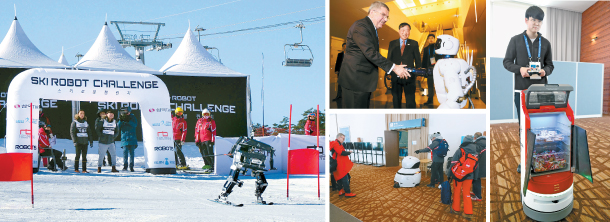At Olympics, robots are cleaning, painting, skiing

Clockwise from left: A humanoid robot skis down a slope in the Ski Robot Challenge, the first of its kind, on the sidelines of the PyeongChang Winter Olympics on Monday at the Welli Hilli Park Ski Resort in Hoengseong County, Gangwon; Thomas Bach, president of the International Olympic Committee, shakes hands with a humanoid robot showcased at the IOC banquet in Gangneung, Gangwon, on Feb. 4; a robot carries drinks in its belly; and journalists observe a cleaning robot. [PYEONGCHANG ORGANIZING COMMITTEE, YONHAP]
The competitors were all humanoid robots ranging in height from 75 to 160 centimeters (2.4 to 5.2 feet). They had mechanic elbows and knees that could bend like a human’s, and they were developed at universities across the country.
The competition was hosted by the Ministry of Trade, Industry and Energy on the sidelines of the Winter Olympics to demonstrate Korea’s prowess in robotics. While the eyes of the world have been fixated on the performance of athletes and the North Korean delegation, robots have been silently stealing attention at the Games.
Eighty-five robots of 11 types have been serving Olympic visitors in various manners at different sites and offering endless amusement. They have been performing tasks from cleaning floors to serving drinks. According to the PyeongChang Organizing Committee, this is the first Olympics where robots have been put to work. Tokyo, which is hosting the Summer Olympics in 2020, is already making plans to use robots as well.
“The PyeongChang Winter Olympics and Paralympics will be the venue for experiencing different kinds of advanced robotic technologies,” Oh Jun-ho, a professor of robotics at the Korea Advanced Institute of Science and Technology (Kaist), said during a media event before the opening of the Games. He has been leading the robot support team in the PyeongChang Organizing Committee.
The machines deployed are diverse. There is a robot that can guide lost visitors, another that shoots projections onto the floor with news and weather, and perhaps the most perplexing, one that swims around in a fish tank.
For many, the first encounter will be at Incheon International Airport, where robots equipped with artificial intelligence software can guide passengers in four languages - Chinese, English, Japanese and Korean.
The cylindrical robots resemble Eve from the Pixar animated film “WALL-E,” but without the two arms and with a large vertical display in the center. They guide passengers to various facilities in the airport including gates, stores and bathrooms.
Users can also get information about transportation options to get to the Games. The robot will show directions and even escort them to the train station inside the airport, where visitors can board a bullet train that heads directly to the Olympic site.
At the Main Press Center in Pyeongchang County, Gangwon, journalists have been receiving news alerts and weather updates through printer-shaped robots that are running around the room beaming high-definition videos onto the floor. Other robots are busy shuttling canned beverages for free to reporters.
At indoor sports venues, robots shaped like the Olympic mascot Soohorang play music and cheers for the audience - and serve as a good selfie partner.
For custodial work, there are robots sucking up - up to 38 liters (10 gallons) - from the floor. Occasionally, they can be heard sending out warnings for people to move out of the way as they do their rounds. A painting robot can reach heights of 20 meters (65.6 feet) and has 10 million colors at its disposal in case any Olympics venues require a paint job.
Also fetching attention are life-size robotic fish swimming around in an aquarium. The 20 fish, each measuring 26 centimeters long and weighing 2.6 kilograms (5.7 pounds), come in two species - seabream and carp - and boast fanciful colors and patterns, though for now they mostly serve aesthetic purposes.
The fish can recognize obstacles and swim 5 meters below the surface for up to 30 hours on a single charge, according to Park Hyun-sub, another Kaist professor on the robot support team.
The professor says most of the robots at the PyeongChang Games perform basic tasks rather than highly sophisticated ones because the technology for service bots is still at a fledgling stage.
Industrial robots, on the other hand, are more actively used. In Korea, there are 630 robots per 10,000 workers, according to Park, a ratio that excels that of Germany and Japan. They are mostly used in assembling vehicles, semiconductors and displays.
The Olympic robots all come from local developers including companies and research institutes, but identifying specific developers is not allowed in order to protect the rights of Olympic sponsors and partners.
“We applied three yardsticks in choosing the robots to use at the Games - how stable, new and useful they are going to be,” Park said.
The idea of using robots at the PyeongChang Games dates back to July 2016. At the Trade Ministry’s request, researchers formed a robot support team under the PyeongChang Organizing Committee responsible for planning, administering and managing robots at the Olympics.
Professor Oh, who created Hubo, a walking humanoid robot completed in December 2004, was entrusted with leading the team. Its initial project was developing a robot to carry the Olympic torch.
Last December, two DRC-Hubos and one FX-2 participated in the torch relay at the Kaist campus in Daejeon.
Hubo is an adaptable robot with the ability to transform from a walking robot to a vehicle on four wheels by bending and using the wheels incorporated into its knees, while the FX-2 is a human-operated robot in which the driver sits inside a seat, almost akin to a robot suit.
BY SEO JI-EUN [seo.jieun@joongang.co.kr]










with the Korea JoongAng Daily
To write comments, please log in to one of the accounts.
Standards Board Policy (0/250자)